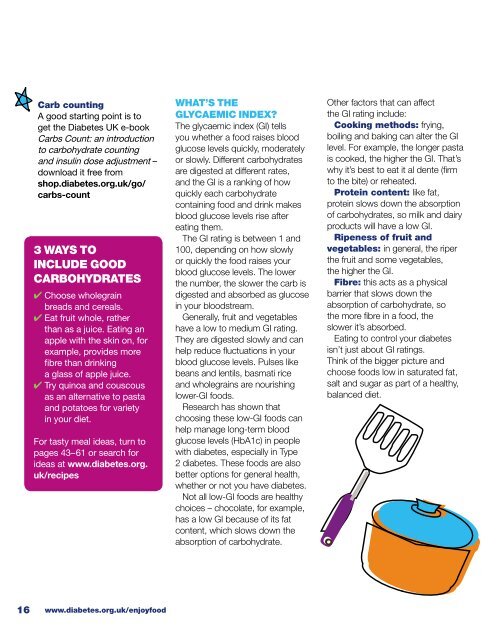Enjoy food
9f7d301hoGi
9f7d301hoGi
You also want an ePaper? Increase the reach of your titles
YUMPU automatically turns print PDFs into web optimized ePapers that Google loves.
Carb counting<br />
A good starting point is to<br />
get the Diabetes UK e-book<br />
Carbs Count: an introduction<br />
to carbohydrate counting<br />
and insulin dose adjustment –<br />
download it free from<br />
shop.diabetes.org.uk/go/<br />
carbs-count<br />
3 WAYS TO<br />
INCLUDE GOOD<br />
CARBOHYDRATES<br />
✔ Choose wholegrain<br />
breads and cereals.<br />
✔ Eat fruit whole, rather<br />
than as a juice. Eating an<br />
apple with the skin on, for<br />
example, provides more<br />
fibre than drinking<br />
a glass of apple juice.<br />
✔ Try quinoa and couscous<br />
as an alternative to pasta<br />
and potatoes for variety<br />
in your diet.<br />
For tasty meal ideas, turn to<br />
pages 43–61 or search for<br />
ideas at www.diabetes.org.<br />
uk/recipes<br />
WHAT’S THE<br />
GLYCAEMIC INDEX?<br />
The glycaemic index (GI) tells<br />
you whether a <strong>food</strong> raises blood<br />
glucose levels quickly, moderately<br />
or slowly. Different carbohydrates<br />
are digested at different rates,<br />
and the GI is a ranking of how<br />
quickly each carbohydrate<br />
containing <strong>food</strong> and drink makes<br />
blood glucose levels rise after<br />
eating them.<br />
The GI rating is between 1 and<br />
100, depending on how slowly<br />
or quickly the <strong>food</strong> raises your<br />
blood glucose levels. The lower<br />
the number, the slower the carb is<br />
digested and absorbed as glucose<br />
in your bloodstream.<br />
Generally, fruit and vegetables<br />
have a low to medium GI rating.<br />
They are digested slowly and can<br />
help reduce fluctuations in your<br />
blood glucose levels. Pulses like<br />
beans and lentils, basmati rice<br />
and wholegrains are nourishing<br />
lower-GI <strong>food</strong>s.<br />
Research has shown that<br />
choosing these low-GI <strong>food</strong>s can<br />
help manage long-term blood<br />
glucose levels (HbA1c) in people<br />
with diabetes, especially in Type<br />
2 diabetes. These <strong>food</strong>s are also<br />
better options for general health,<br />
whether or not you have diabetes.<br />
Not all low-GI <strong>food</strong>s are healthy<br />
choices – chocolate, for example,<br />
has a low GI because of its fat<br />
content, which slows down the<br />
absorption of carbohydrate.<br />
Other factors that can affect<br />
the GI rating include:<br />
Cooking methods: frying,<br />
boiling and baking can alter the GI<br />
level. For example, the longer pasta<br />
is cooked, the higher the GI. That’s<br />
why it’s best to eat it al dente (firm<br />
to the bite) or reheated.<br />
Protein content: like fat,<br />
protein slows down the absorption<br />
of carbohydrates, so milk and dairy<br />
products will have a low GI.<br />
Ripeness of fruit and<br />
vegetables: in general, the riper<br />
the fruit and some vegetables,<br />
the higher the GI.<br />
Fibre: this acts as a physical<br />
barrier that slows down the<br />
absorption of carbohydrate, so<br />
the more fibre in a <strong>food</strong>, the<br />
slower it’s absorbed.<br />
Eating to control your diabetes<br />
isn’t just about GI ratings.<br />
Think of the bigger picture and<br />
choose <strong>food</strong>s low in saturated fat,<br />
salt and sugar as part of a healthy,<br />
balanced diet.<br />
16<br />
www.diabetes.org.uk/enjoy<strong>food</strong>


